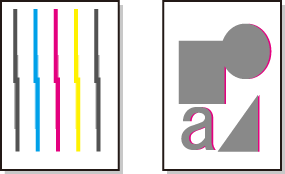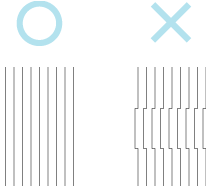Adjusting the Printhead - iPF8300
| Article ID: ART106416 | | | Date published: 05/11/2015 | | | Date last updated: 08/15/2015 |
Solution
If printing is faint or affected by banding in different colors, make sure the Printhead nozzles are clear by printing a test pattern to check the nozzles.
Note:- Nozzles are periodically checked to ensure they are clear. Configure the settings on the Control Panel menu in Nozzle Check.
1. Load unused paper.
2. On the Tab Selection screen of the Control Panel, press  or
or  to select the Settings/Adj. tab
to select the Settings/Adj. tab ![]() .
.
Note:
- If the Tab Selection screen is not displayed, press the Menu button.
3. Press the OK button.
The Set./Adj. Menu is displayed.
4. Press  or
or  to select Test Print, and then press the OK button.
to select Test Print, and then press the OK button.
5. Press  or
or  to select Nozzle Check, and then press the OK button.
to select Nozzle Check, and then press the OK button.
6. Check the printing results.
If the horizontal lines are not faint or incomplete, the nozzles are clear.
![]()
If some sections of the horizontal lines are faint or incomplete, the nozzles for those colors are clogged.
![]()
If horizontal lines are faint or incomplete, follow the steps below and check again for nozzle clogging.
1. Clean the Printhead.
2. Print a test pattern to check the nozzles.
Note:- If you repeat these steps several times but the horizontal lines are still faint or incomplete, contact the Canon Dealer.
If vertical lines in printed documents are warped or colors are out of alignment, execute Head Posi.Adj.. The printer will print and read a test pattern, and the Printhead position will be adjusted automatically.
There are three modes for automatic Printhead adjustment: Auto(Standard), Auto(Advanced), and Auto(Expansion).
- Auto(Standard)
Fixes slight distortion and color misalignment. - Auto(Advanced)
Try adjustment in this mode if Auto(Standard) does not improve printing. - Auto(Expansion)
Try adjustments in this mode if vertical lines are warped or colors are out of alignment when the printer driver option High-Precision Photographs or High-Precision Text and Fine Lines is selected.
- Always make sure the loaded paper matches the type of paper specified in the printer. Adjustments cannot be completed correctly unless the loaded paper matches the settings.
- This function is not available with CAD Tracing Paper or CAD Translucent Matte Film.
If adjustment is not possible as expected using highly transparent film or similar media, try another type of paper, or try Manual adjustment.
Note:
- Auto(Expansion) may be unavailable in some cases, even if it is displayed in the menu. If so, execute Auto(Advanced) once.
- When printing on special paper, or if printing is not improved after Auto(Advanced), try Manual.
- Use Auto(Standard) if you have switched to another type of paper or if you want the boundaries between colors to appear as attractive as possible.
- Use Auto(Advanced) to fine-tune the space between nozzles or colors if you have switched the printhead or if clearer printing is required. We recommend using Auto(Advanced) for printing at the highest level of image quality.
- Always make sure the loaded paper matches the type of paper specified on the printer. Adjustment cannot be completed correctly unless the loaded paper matches the settings.
- We recommend using the type of paper you use most often for adjustment.
Items to Prepare
- Rolls - An unused roll at least 10 inches wide
- Sheets - Auto(Standard): Three sheets of unused paper, A4/Letter size (or one sheet when using A2)
Auto(Advanced): 11 sheets of unused paper, A4/Letter size (or three sheets when using A2)
Auto(Expansion): Seven sheets of unused paper, A/4 Letter size (or two sheets when using A2)
Perform adjustment as follows.
1. Load the paper.
2. On the Tab Selection screen of the Control Panel, press  or
or  to select the Settings/Adj. tab
to select the Settings/Adj. tab ![]() .
.

Note:
- If the Tab Selection screen is not displayed, press the Menu button.
3. Press the OK button.
The Set./Adj. Menu is displayed.
4. Press  or
or  to select Adjust Printer, and then press the OK button.
to select Adjust Printer, and then press the OK button.
5. Press  or
or  to select Head Posi. Adj., and then press the OK button.
to select Head Posi. Adj., and then press the OK button.
6. Press  or
or  to select Auto(Standard), Auto(Advanced) or Auto(Expansion), and then press the OK button.
to select Auto(Standard), Auto(Advanced) or Auto(Expansion), and then press the OK button.
A test pattern is printed for adjustment.
Adjustment is now finished if you have a printed on a roll.
7. If you are printing on sheets, a confirmation message is displayed requesting you to continue printing. Press the OK button and follow the instructions displayed..
If printed vertical lines are warped or colors are out of alignment, execute Head Posi.Adj. to adjust the Printhead alignment.
Normally, execute Auto(Standard), Auto(Advanced), or Auto(Expansion).
However, when printing on special paper, or if printing is not improved after Auto(Advanced), try Manual. Manual adjustment requires you to examine the printed test pattern and enter an adjustment value.

Note:
- Manual may not be available in some cases, even if it is displayed in the menu. If so, execute Auto(Advanced) once.
- Always make sure the loaded paper matches the type of paper specified on the printer. Adjustment cannot be completed correctly unless the loaded paper matches the settings.
- We recommend using the type of paper you use most often for adjustment.
Items to Prepare
- Rolls - An unused roll at least 10 inches wide
- Sheets - Three sheets of unused paper, A4/Letter size (or one sheet when using A2)
Perform adjustment as follows:
1. Load the paper.
2. On the Tab Selection screen of the Control Panel, press ![]() or
or  to select the Settings/Adj. tab
to select the Settings/Adj. tab ![]() .
.

Note:
- If the Tab Selection screen is not displayed, press the Menu button.
3. Press the OK button.
The Set./Adj. Menu is displayed.
4. Press  or
or  to select Adjust Printer, and then press the OK button.
to select Adjust Printer, and then press the OK button.
5. Press  or
or  to select Head Posi.Adj., and then press the OK button.
to select Head Posi.Adj., and then press the OK button.
6. Press  or
or  to select Manual, and then press the OK button.
to select Manual, and then press the OK button.
A test pattern is printed for adjustment.
7. Press  or
or  to select D, and then press the OK button.
to select D, and then press the OK button.
8. Press  or
or  to select D-1, and then press the OK button.
to select D-1, and then press the OK button.
9. Examine adjustment test pattern D-1 and determine the number with straight lines.

Note:
- If two patterns seem equally good and you cannot decide which one is better, choose an intermediate value. For example, choose 11 if you cannot decide whether pattern 10 or 12 is better.
10. Press  or
or  to select the pattern number you have decided, and then press the OK button.
to select the pattern number you have decided, and then press the OK button.
11. Repeat steps 8 and 10 to specify the adjustment value for D-1 to D-5, D-7 to D-12, D-25 to D-29, and D-31 to D-36.
12. Press the Back button.
13. Press  or
or  to select Register Setting, and then press the OK button.
to select Register Setting, and then press the OK button.
13. Press  or
or  to select Yes, and then press the OK button.
to select Yes, and then press the OK button.
The adjustment value is now registered, and adjustment is complete.
